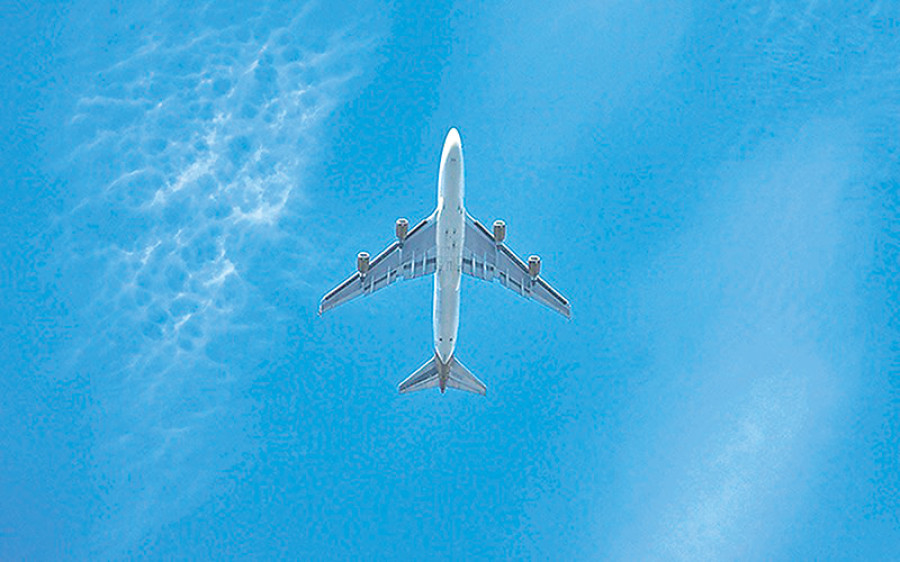Opinion
The sky is the limit
India’s refusal to grant two-way western air routes is a barrier for Nepali airlines
Hari Prasad Shrestha
The 2015 blockade by India prompted Nepal to sign a trade and transit treaty with China; and this year, the two countries signed the protocol to the treaty relating to Nepal’s use of Chinese sea and land ports. India’s recent refusal to grant two-way western air routes could possibly push Nepal and China closer, and encourage use of more northern air routes. Nepal could have a hard time operating flights to the Middle East and Europe from the three international airports under construction with India turning down its request for air routes through Mahendranagar and Nepalgunj.
Nepal’s decision to pull out of the joint military exercise held among the member states of the Bay of Bengal Initiative for Multi-Sectoral Technical and Economic Cooperation (BIMSTEC) in Pune could be one of the reasons for India’s refusal. India wanted priority consideration to build Nijgadh International Airport and the Kathmandu-Tarai Expressway. But Nepal refused to award the construction contract for the expressway to an Indian company as that would result in heavy losses to the government.
India may offer to allow Nepal to use its air space on the condition that an Indian air marshal be placed on flights to Nepal. It may also impose conditionalities during the construction of Nijgadh International Airport. India seems to be concerned that the construction of a large airport in Nepal will lure away flights from New Delhi and Kolkata airports. Moreover, India is not happy with the construction of Gautam Buddha International Airport in Bhairahawa, as authorities are still creating confusion that Buddha was born in India.
Despite India’s refusal to grant additional air routes, China is building international airports in Nepal. Gautam Buddha International Airport and Pokhara International Airport are expected to be up and running in one and three years respectively. Nijgadh International Airport, envisaged to be an alternative to Kathmandu’s Tribhuvan International Airport, is in the initial stages of construction. The airport in Pokhara is being built with Chinese assistance, and its construction was partly prompted by growing Chinese arrivals to the lake city. Bhairahawa International Airport is also being built by a Chinese company. Lumbini and Pokhara are Nepal’s key tourist hubs. Both are popular destinations for Chinese tourists, and China will certainly benefit by flying Chinese travellers to these airports.
Due to India’s refusal to grant air routes, aircraft flying to Gautam Buddha International Airport will have to take a longer route which will raise the operating costs for airlines and push up ticket prices. According to the Civil Aviation Authority of Nepal (CAAN), aircraft flying from New Delhi to Bhairahawa will have to fly an extra 300 km as a result. The international airport in Pokhara will face a similar problem if new cross-border air routes do not come into operation soon. If the Nepalgunj or Mahendranagar airspace is not implemented in the near future, Pokhara-bound international flights coming from the western part of Nepal will have to fly an additional 185 km. The extra flight time will raise operating costs and make fares costlier.
Moreover, private airlines are in the process of starting flights to cities in the neighbouring country in the near future from four regional airports in the Tarai—Nepalgunj, Biratnagar, Janakpur and Dhangadhi. Buddha Air has announced that it will be operating flights to Delhi from the regional airport in the western plains town of Nepalgunj. This route is expected to boost Indian tourist arrivals to Nepal’s western and far western regions by 100,000 individuals, especially of pilgrims headed for Kailash Manasarovar in China.
India’s refusal to grant this route will hit the airline’s planned Delhi service. However, there is a possibility of operating flights between Nepalgunj and Nagari Gunsa Airport in Tibet, China for Manasarovar-bound pilgrims if Nepal submits a proposal to China. Nepal’s Shree Airlines is also in the process of obtaining permission to operate flights from regional airports to destinations in India. Nepal and Bangladesh are close to signing an agreement to launch a service between Biratnagar and Saidpur airport, Bangladesh.
In August 2014, a joint communiqué issued by Nepal and India said, “The cross-border direct routes will facilitate flights between regional airports in Pokhara and Bhairahawa, and this will save time and money for air travellers and also improve air connectivity between India and Nepal.” India’s refusal to grant previously agreed air routes shows its intention to always keep Nepal in its sphere of influence, and it could go to extreme lengths to harm Nepal. This will not only affect Nepali airlines, but also bring misfortune to Indian airlines. Nepal should not, and cannot, go against India; but it must apply diplomatic pressure against this air route barricade.
Shrestha is a former under-secretary of finance and served with the UNDP in South Sudan and Sierra Leone.




 5.4°C Kathmandu
5.4°C Kathmandu










%20(1).jpg&w=300&height=200)

